| Evening Telegraph, August 4th 1944
Wymington Bomber Crash
On the evening of Thursday August 3rd 1944, the tiny Bedfordshire Village of Wymington faced almost certain destruction. An American B17 Flying Fortress returning from its mission that day to Merkwiller France, was trying to make an emergency landing at Chelveston. Due to the severity of damage to this plane the two Pilots' were faced with a dilemma; to save themselves and try for open country and a forced landing or to make the ultimate sacrifice and avoid the centre of the Village below thus saving many more lives.
Lt's Thomas Barnett and Donald Morrill made the latter choice, welding their stricken machine into almost unbelievable manoeuvres, effecting almost miraculous feats of airmenship. Their bomber had lost two engines, a third on fire and the fourth and last remaining at full power and exceeding its manufacturers limits.
Many watched the arrival of this plane, residents of those very same cottages that lay directly beneath the unfolding and fast approaching disaster. Members of the Home Guard rallied and began to run along the High Street to where they supposed the plane would crash. Others of the Village Fire Brigade also took part, arriving from the Rectory in their converted V8 Pilot car.
The plane almost managed to clear the top most of Wymington at the point of Popular farm - save for one solitary elm of some 60 feet in height. At some 90 knots the bomber struck the top most part of this tree, severing an estimated eight feet from it. The impact slew the whole plane around, tipping its starboard wing downwards and somehow by fate allowing it to pass behind the farmhouse and the ancient hay barn nearby. Now on a wingtip attitude, the bomber passed right over the heads of the Homeguard standing in the High street. In a second or two, it struck the field opposite the farm and spun around; slamming into the earth in almost one piece. It was now facing the direction of Poplar farm.
Fire erupted immediately, first a tiny flame or two, and then in a blink of an eye those very same flames grew to twenty or more feet high. Fifty calibre bullets fired off as the heat expanded their casings. Tracer shells lit up the field along with the increasing flames. Fuel was spilling from a number of gashes within the wing tanks, dripping like rain onto the field all around setting it also on fire.
The men of Wymington did their best and more to try and rescue the crew from this inferno. Research has indicated that all but the three were rescued; these could not be reached due to the intense heat and flame. Of the bodies pulled clear two were barely alive; they being Frank Schmidmeister and Rich Jasionowiecze. Sadly Jasionowiecze died the next day, but Frank survived and is alive today.
The other survivor had an amazing escape after being thrown clear of the plane just before impact. He, Floyd Rowe, was found some time afterwards and is also alive today.
|
|
Evening Telegraph, Tuesday 15th August, 1944
Eight Heroes of Wymington Rescued Airmen from Blazing ’Plane Wreckage Despite Explosion Risk
Meeting in the village school on Monday evening, the A.R.P. Wardens and First Aid Point personnel of Wymington, near Rushden, "reconstructed" an affair in which they took part some weeks ago—the crash of a flying Fortress near the village; the rescue of airmen from the blazing wreckage, and the general working of the A.R.P. arrangements. Having discussed the incident from every angle, they went home expecting to hear no more of it.
A few hours later, however, the American Army Air Force European H.Q. announced to the world that on the occasion just reviewed the people of Wymington had behaved magnificently. It named eight of the 500 residents, together with a Czech soldier, as men who had behaved with great courage in dragging dead and injured airmen from the wreckage while tracer bullets, cannon shells and flares were exploding all around them.
Rush To Help
Battered by A.A. fire the Fortress was limping home from a raid when it struck a tree top, somersaulted and crashed in a field near Wymington High-street. Villagers heard the crash—they had been watching anxiously as the plane skirted round the houses—and says the U.S. H.Q., "The men reacted as a group in rushing to the wrecked plane to help the trapped airmen."
The Fortress was in imminent danger of exploding, but Reginald Tobin, Richard Bristow, Herbert Fuller, George Dickerson and Michael Smith rushed to the wreckage scattered far over the field and hauled two airmen, one still alive, from the nose of the plane.
Leo Tobin, Victor Watts, Jack Lewis and the Czech soldier, Svob Harry Bartonieck, went to the tail and pulled out four airmen—two alive and two dead.
"Did All We Could"
Mr. George Dickerson, a heating engineer, who lives in High-street, Wymington, told the "Evening Telegraph" this morning (Tuesday):
"I heard the crash, ran into the street, and saw the flames and smoke going up. We ran up to the 'plane and did what we could, and that's about all there is to it. I didn't expect to hear any more about it. Bullets were going off all the while, and when we heard the bangs we ducked—you didn't know what was going to happen.
"The wreckage was strewn right across the field. I helped to remove two men from the nose of the plane; one was dead and the other was just alive. There were two men near the fire who could not be got out but with this ....."
Effort to Avoid Village
Mr. Dickerson and others, declare that the Fortress pilot must have made a great effort to avoid crashing on the village. The plane cleared some trees near the Rectory, then altered course to avoid the church and houses, and finally came to grief over some rising ground and tall trees.
"It was an extraordinarily good job of work on the part of the villagers," said Mr. J W Reynolds, J.P. C.C., the Senior Air Raid Warden, "There was no question of waiting to see if there was any danger."
War Reserve Constable R. Tobin, who is tall and a good runner, was the first to reach the wreckage, followed closely by a farmer's wife, Mrs. J. W. Smith, who as leader of the village First Aid Point sent for all available first aid kits. The Wymington N.F.S. men were quickly on the spot, and units arrived from the nearest towns. P.C. Duncan also did valuable work, and Mr. Frederick Mitchell of Manor-lane, who is in ill health and lame, helped until the smoke affected him.
The Eight Men
The men named by the American authorities are Leo Tobin, boot operative and Home Guard; Victor Watts, aged about 16, boot operative and Home Guard; Jack Lewis, boot operative and Home Guard corporal; Reginald Tobin, War Reserve policeman; Richard Bristow, painter and decorator, formerly of London; Herbert Fuller, boot operative and discharged Territorial; George Dickerson, heating engineer; Michael Smith, aged about 15, who has just joined the Home Guard.
|
|
Memories of the Crash
|
| Mrs Stella Zaremba was a child living in Wymington at the time of the crash. In the days after the rescue, and whilst much of the debris still remained, Stella collected two pieces of silk. One was the complete silk escape map, the second a small scrap which was part of another map. This second smaller piece was burned around its edges, clearly having been close to the fire, these are the only known physical items to survive that relate directly to “ Miss Liberty Belle” and her final mission. |
| Eight Wymington villagers, and a Czech soldier, were named as heroes by the European Headquarters of the U.S. Strategic Air Forces. The eight villagers showed their courage when with ammunition and flares exploding in every direction, they unhesitatingly went up to a crashed and blazing Flying Fortress to drag out dead and injured airmen. European H.Q. names them all: Leo Tobin, Victor Watts, Jack Lewis, Reginald Tobin, Richard Bristow, Herbert Fuller, George Dickerson and Michael Smith – eight men who will doubtless be mighty surprised today to find themselves heroes. And the Czechoslovakian soldier who shares with them in the tribute of European H.Q. is Svob Harry Bartonieck. The fortress battered by AA fire was limping home from a raid when it crashed.
“The men reacted as a group in rushing to the wrecked plane to help the trapped airmen”, says the U.S.H.Q. While the roaring flames exploded ammunition and flares, Leo Tobin, Victor Watts and Jack Lewis and the Czech soldier went to the tail and pulled out four airmen – two alive and two dead.
These and another airman who had collapsed after staggering a short distance from the burning bomber were carried to safety. Other villagers, Reginald Tobin, Richard Bristow, Herbert Fuller, George Dickerson and Michael Smith hauled out of the nose of the Fortress, two other airmen, one still alive.
“The burning Fortress was in imminent danger of exploding,” says the statement.
|
Another recollection of the crash comes from Olive Perkins, who lives in South Grove:
“Concerning the B17 that crashed in the field next to the one we called the Crow Gardens, this aircraft, piloted by Pilot Lt. Thomas O. Barnett, and called the “ Liberty Belle”, was shot up over the target area, (Oil Refinery at Merkwiller) on August 3rd 1944. It returned to Chelveston on three engines. It was just very unfortunate that the engine that they lost, supplied the power to the hydraulics, which operated most things on the plane, including the undercarriage. So this aircraft was asked to circle whilst the rest of the squadron landed, (had this one landed, it most probably would have crashed, and blocked the main runway). Whilst it was still in circuit, it suffered a second engine failure, on the same side, this made it impossible to maintain height, and it all but crashed on Wymington village, it lifted over the church by a few inches, and cartwheeled across the field, disintegrating as it went, and catching fire. This had been observed by almost the whole village, and 8 men and a Czech soldier pulled the crew from the wreck in complete disregard for the huge flames and exploding flares and ammunition. Of the 9 men aboard, six were dead, and one of the injured died later in hospital. All nine of the rescuers received a citation for bravery of the highest honour in a special award from the American authorities. My brother, Herbert, was one of the men who received an award, and at Christmas he used to get a Christmas card from one of the survivors. I don’t know what happened to his citation and he is now dead”. Olive Perkins
|
Evening Telegraph newsclip, 1999 - by Mark Moore
|
| VILLAGERS met a group of US World War II veterans to commemorate a tragic air disaster that happened more than 55 years ago.
The ceremony was held at Poplar Farm, Wymington, yesterday. It was held at the spot where seven American airmen lost their lives in a plane crash, in August 1944, after steering their aircraft clear of village buildings.
One of the survivors of the disaster, Floyd Rowe, flew from America to attend the ceremony where tribute was paid to the airmen's bravery, and a plaque was unveiled in their memory.
Villager Michael Smith, who, in 1944, helped pull the survivors from the wreckage, told the gathering: "This event is to recognise and remember the crew of the flying fortress, which crashed here. It was a dreadful experience for those concerned."
It was not until recently that villagers found out that survivors of the disaster were still alive. It has taken three years of painstaking research work for the ceremony's organiser, Ian White, to bring everyone together to remember those who died.
It was an emotional afternoon for both the residents of Wymington and the former American airmen who had made the trip to the ceremony.
Mr Smith addressing the airmen said:
"We did not know for sure whether anybody had survived this crash. It was a frightening experience for all of us. Our thanks go out to you for the work that you did at that time."
|
The Crew by name and position when the 365th arrived at Chelveston:
Tom Barnett (First Pilot)
Rowland Wing (Co-Pilot)
Eugene Bonas (Bombardier)
John Rutherford (Navigator)
Floyd Rowe (Flight Engineer)
Don McQueary (Radio)
Francie (Smitty) Schmidmeister (Waist)
Rick (Murph) Jasionowieze (Ball Waist)
Chuck (Red) Naden (Tail)
Robert Courneyer (Ball Waist)
|
|
|
A tribute to the men who died
is displayed in the New Inn
|
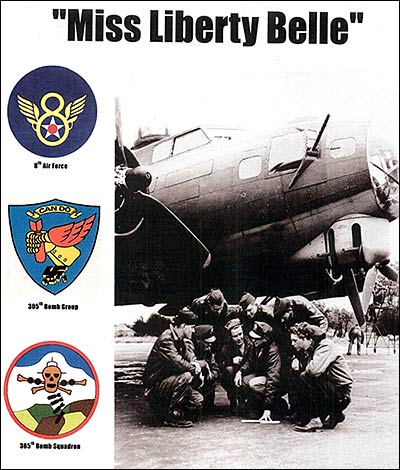 |
July 7th 1944 Lt Challen Hunt and the crew with 'Miss Liberty Belle' 365th Squadron – 305th Bomb Group, based at Chelveston airbase.
It crashed at Wymington on August 3rd 1944.
|
|
The crew of the ill fated Miss Liberty Belle. The two surviving airmen are on the left hand side of the bottom and middle rows.
|
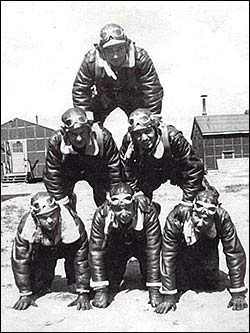 |
|
|
The Unveiling of a Memorial to the Crew and the “Heroes of Wymington”, took place on 7th May 2000. Representatives of the U.S. Air Force, survivor Floyd Rowe, the widow of Robert Courneyer, one of the men who died, and many local people attended.
There was a one minute silence. A flypast by an American World War II aeroplane ended the ceremony. Anglia Television recorded the event and it was broadcast on the evening news.
|
|
|
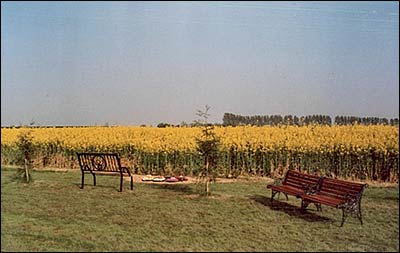 |
|
The Memorial site
|
|
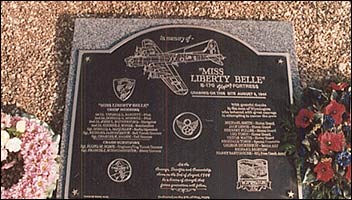 |
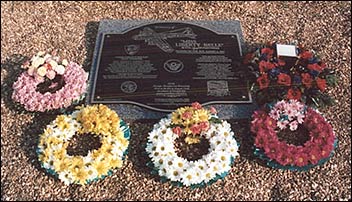 |
|
The Memorial Plaque and Flowers
|
|
|